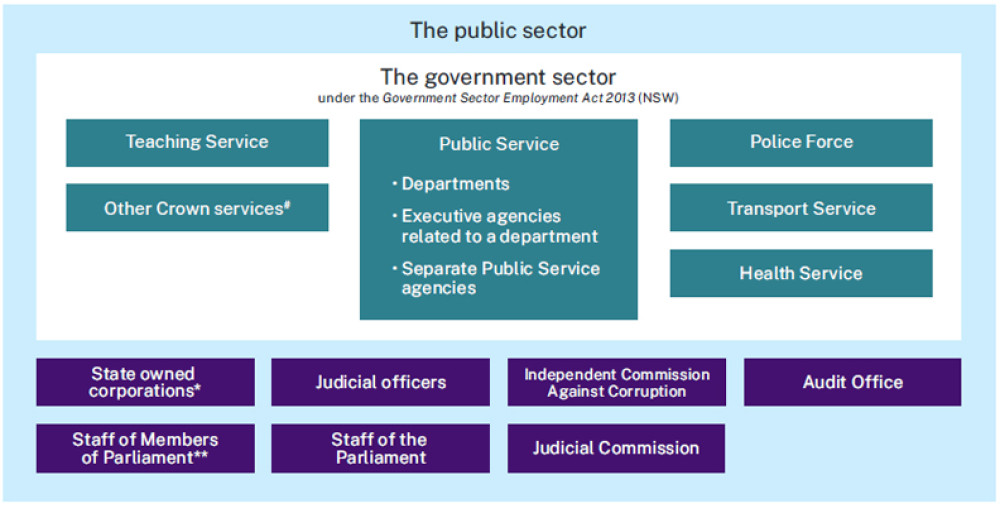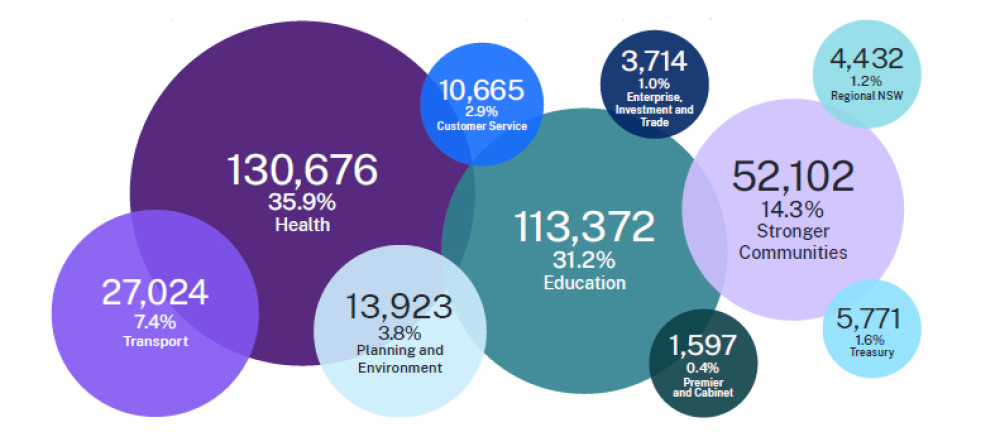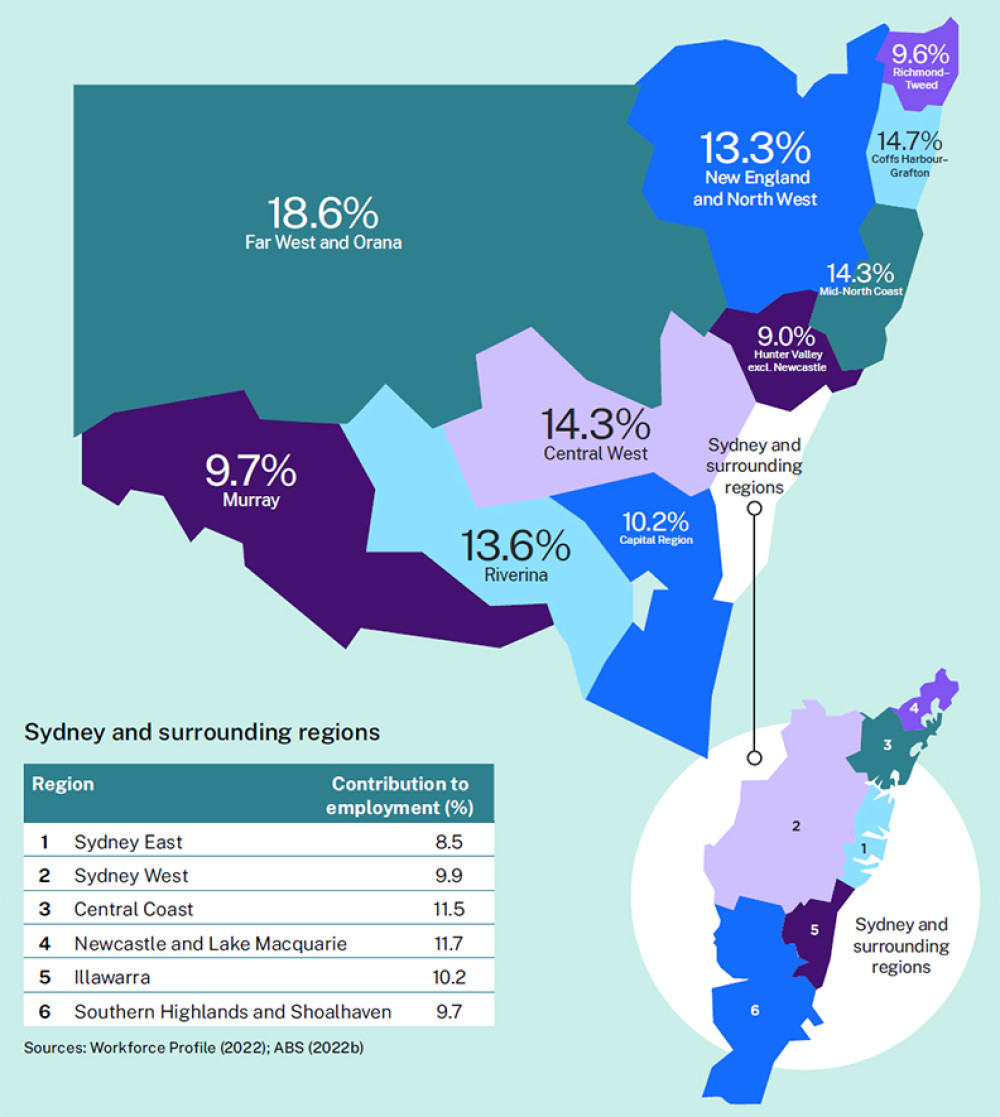Over 400,000 employees work in the NSW public sector to deliver a wide range of services to the people of NSW. The sector is divided into 10 operational clusters that coordinate, develop and provide related services and policy. Each cluster oversees the delivery of government services across NSW.
Headcount and full-time equivalent employees
433,890
ongoing, temporary and casual employees
equating to 363,617
full-time equivalent employees
Source: Workforce Profile (2022), census period
The number of full-time equivalent (FTE) employees in the sector increased by 3,427 (or 1.0%) from 2021 to 2022, to support service delivery across the state.
Source: Workforce Profle (2013–22), census period
The number of people employed in the sector increased by 0.6% in 2022. The sector’s growth was outpaced by growth in the number of people employed in NSW overall, which was up 2.8%.
Source: Workforce Profle (2018–22); ABS (2022a)
Structure of the NSW public sector
The GSE Act establishes two main employment groups: the government sector and the Public Service within it. Most government employees are in the government sector.
The public sector is also structured into 10 operational clusters that coordinate related day-to-day public services, each led by a secretary. The term ‘cluster’ is commonly used for administrative purposes; however, clusters are not established by legislation.

The public sector covers the government sector (under the Government Sector Employment Act 2013 (NSW) (GSE Act), which includes six areas: the Teaching Service, Other Crown services#, the Public Service (including departments, executive agencies related to departments and separate Public Service agencies), the Police Force, the Transport Service and the Health Service.
Also under the umbrella of the public sector, but outside the government sector, are seven areas: State owned corporations*, Staff of Members of Parliament**, Judicial officers, Staff of the Parliament, the Independent Commission Against Corruption, the Judicial Commission and the Audit Office.
# Examples of other Crown services include the TAFE Commission, School Administrative and Support Staff, and Sydney Trains.
* Under the GSE Act, State owned corporations are included in the government sector for certain specified purposes. In this report, they are treated as part of the public sector but not the government sector.
** The PSC does not collect data on these employees.
Under the GSE Act, NSW universities are part of the government sector for certain specified purposes. The PSC does not collect data on the employees of NSW universities. They are not considered part of the public sector or government sector in this report.
Full-time equivalent employees by cluster

| Cluster | FTE | % |
|---|---|---|
| Health | 130,676 | 35.9 |
| Education | 113,372 | 31.2 |
| Stronger Communities | 52,102 | 14.3 |
| Transport | 27,024 | 7.4 |
| Planning and Environment | 13,923 | 3.8 |
| Customer Service | 10,665 | 2.9 |
| Regional NSW | 4,432 | 1.2 |
| Enterprise, Investment and Trade | 3,714 | 1.0 |
| Premier and Cabinet | 1,597 | 0.4 |
| Treasury | 5,771 | 1.6 |
Source: WFP (2022), census period
Note: Percentages indicate the contribution of the cluster’s FTE to the public sector’s total FTE.
Headcount and contribution to overall employment by NSW region
The NSW Government is a significant employer in every part of the state. Most public sector employees work in Sydney (59.1%). However, the sector contributes relatively more to overall employment in regional areas of NSW than it does to employment in Sydney.
In 2022, 65.7% of public sector employees worked in a metropolitan area (Sydney, Newcastle and Wollongong), compared with 34.3% in regional NSW. Additionally, 65.4% of the NSW Estimated Resident Population are in the metropolitan area, compared with 34.6% in regional NSW.

Greater NSW
| Region | Contribution to employment (%) |
|---|---|
| Hunter Valley excl. Newcastle | 9.0 |
| Mid-North Coast | 14.3 |
| New England and North West | 13.3 |
| Far West and Orana | 18.6 |
| Coffs Harbour – Grafton | 14.7 |
| Richmond – Tweed | 9.6 |
| Capital Region | 10.2 |
| Riverina | 13.6 |
| Murray | 9.7 |
| Central West | 14.3 |
Sydney region
| Region | Contribution to employment (%) |
|---|---|
| Sydney East | 8.5 |
| Sydney West | 9.9 |
| Central Coast | 11.5 |
| Newcastle and Lake Macquarie | 11.7 |
| Illawarra | 10.2 |
| Southern Highlands and Shoalhaven | 9.7 |
Sources: Workforce Profile (2022); ABS (2022b)
Occupations
The NSW public sector employs people in a wide range of occupations.
69,830 School Teachers
down from 70,270 in 2021
51,880 Nurses
up from 51,441 in 2021
17,033 Police Officers
down from 17,174 in 2021
48,701 Clerical and Administrative Workers
up from 47,406 in 2021
26,261 School Support Staff
up from 25,802 in 2021
13,674 Medical Practitioners
up from 13,190 in 2021
7,834 Social and Welfare Professionals
down from 7,886 in 2021
5,151 Cleaners and Laundry Workers
down from 5,220 in 2021
5,164 Ambulance Officers
up from 4,745 in 2021
4,246 Labourers
down from 4,605 in 2021
3,967 Prison Officers
down from 4,297 in 2021
4,252 Firefighters
up from 4,157 in 2021
59 Bus Drivers
down from 2,665 in 2021
2,217 Train Drivers
up from 2,074 in 2021
1,983 Food Preparation Assistants
down from 1,988
Source: Workforce Profile (2021, 2022), census period
Note: Teacher staffing allocations are predominantly driven by student enrolments. In 2022 the student enrolment in NSW Public Schools decreased, resulting in a corresponding decrease in teaching FTE. Student to staff ratios remain steady. The decline in Police Officers was due to a higher number of separations, including medical retirements, and lower number of commencements. While the FTE number of Prison Officers declined, the headcount increased. The decline in bus drivers is due to the movement of service delivery outside of the public sector.
Employment types
The type of employment that the NSW public sector offers varies to ensure the sector can flexibly deliver services; however, most people are employed on an ongoing basis. There has been stabilisation across all employment types over the past two years. The wide variety of roles within the NSW public sector means that our people are employed across a wide remuneration range.
Source: Workforce Profile (2013–22), census period
Note: The ‘Other’ category includes employees whose employment category is Contract Executive, Contract Non-Executive, Statutory Appointee, Transport Senior Manager or Other.
Source: Workforce Profile (2013, 2018, 2022), census period, non-casual only
Note: To provide a whole-of-sector perspective, remuneration has been aligned with the non-executive grades defined in the Crown Employees (Administrative and Clerical Officers – Salaries) Award 2022. The GSE Act provides for the Premier to determine the bands in which bands senior executives are employed. Currently, there are four bands.
-
Next section: our people
Who we are and how we feel at work.